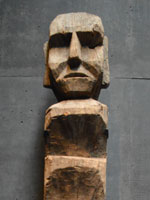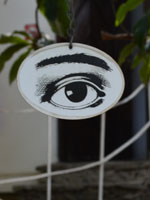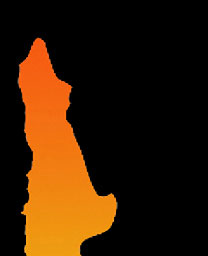

|
Wandering through the museums and barrios of SantiagoI started off the day with another rush hour ride on the subway. This time my destination was the Quinta Normal, a large park just to the east of central Santiago. In addition to lots of greenery and gardens, the Quinta Normal is also home to the oldest natural history museum in Latin America. I had a little time before the museum opened, so I wandered around the park and found the Invernadero, an old greenhouse in a sad state of abandon and ruin. Similar in design to the Conservatory of Flowers in San Francisco, the Royal Botanic Gardens in London, and the Palacio de Cristal in Madrid, the Invernadero made for a tragic photographic study. The wrought-iron grillwork was rusting away, the glass panes broken or gone altogether, and every possible surface was covered in graffiti, leaving a solitary monument to a bygone era. After exploring and photographing the Invernadero, I walked a short distance through the park to the Museo Nacional de Historia Natural (National Museum of Natural History). Like any good natural history museum, it is old and funky, filled with the requisite dusty dioramas and tawdry taxidermy, and the shreiks of hundreds of schoolchildren. All of this is part of its charm. But the main exhibit in the central hallway is truly amazing, a gigantic skeleton of a sei whale, collected in 1889 on a beach south of Valparaíso. Mounted on a large platform, the whale fills up the massive space, its skull the size of an automobile and its tail extending down the hall 60 feet away. Across the street from the Quinta Normal is the somber Museo de la Memoria y de los Derechos Humanos (Museum of Memory and Human Rights). I took my time going through the three floors of exhibits, trying to absorb the horror of what happened in this country on September 11, 1973. It's a particularly painful story to comprehend as a norteamericano, considering our country's complicit role in the murder and disappearance of 3,000 people, and the torture of more than 30,000 people. Chile is making a powerful effort to come to terms with the horrors that took place during the Pinochet dictatorship. The Museo de la Memoria y de los Derechos Humanos is just one of a number of museums, monuments, and memorials throughout the country that are dedicated to remembering this dark period in the nation's history. The word that comes up again and again is Memoria – Memory; the Chilean people are determined to never forget what happened. Arte callejero in the barrios of Santiago.From the Museo de la Memoria y de los Derechos Humanos, I walked slowly back along the Calle Catedral into the central city. The route took me through Barrio Brazil, an unassuming neighborhood centered around the warm and friendly Plaza Brazil. The plaza was filled with people enjoying the afternoon sun and the spot of greenery in a dense urban landscape. I then continued down the Calle Catedral until I got to the Plaza de Armas, the very center of Santiago. The Plaza de Armas is a large square surrounded by some of the oldest buildings in Santiago. Although the city was founded in 1541, Santiago has been destroyed by earthquakes so many times that it does not have the rich colonial heritage that is found in much of Latin America. But the Cathedral of Santiago, the fifth one constructed on this site, dates back to 1748. I was disappointed to see that the entire Plaza de Armas was undergoing a renovation and looked more like a construction site than the cultural center of the city. The Cathedral was completely covered up, hiding the beautiful colonial features of its architecture. Just a block away from the Plaza de Armas is the Museo Chileno de Arte Precolombino, the Chilean Museum of Precolumbian Art. I really loved this museum and spent much of the afternoon there. It far exceeded my expectations, with extensive exhibits on the indigenous cultures of Chile, but also of the Mayas, Aztecs, and other cultures of Latin America. Downstairs from the main entrance is a darkened room with a spectacular collection of Mapuche Chemamulles, large wooden statues that were used in funerary rites. After the ceremonial burial of a deceased person, the statues were then placed as grave markers in the cemetary. Another impressive exhibit showed Inca Quipus, intricately knotted cords that were used for recording numeric information and keeping records. When I left the Museo Chileno de Arte Precolombino, it was time for a late lunch. I walked a few blocks up Calle Ahumada to the Mercado Central, a vast market located in a beautiful old building near the river. It was a big disappointment though, proving to be more of a tourist trap than a marketplace. I had a mediocre bowl of ceviche at Donde Augusto, one of the restaurants where aggressive touts fought each other for customers. I left the Mercado Central still hungry and continued my exploration of the city. By late afternoon, I reached the Centro Cultural Gabriela Mistral, a modern arts complex named in honor of the Nobel Prize-winning poet. One of the big exhibits taking place was a photographic show called Parra 100, dedicated to the poet Nicanor Parra, the older brother of folksinger Violeta Parra and member of a large family of artists, musicians, and poets. Parra, who refers to himself as the "anti-poet" because of his unorthodox style that flies in the face of poetic norms, just turned 100 years old a couple of months ago. After an earthquake damaged his home in 2010, a suitcase full of photographs was dislodged from an interior wall, documenting the many decades of his life and forming the basis of this exhibit. Video: It takes about three and a half minutes to ride the funicular to the top of Cerro San Cristobál, but the ride flies by in 27 seconds in this video. I ended the long day of exploration in Barrio Bellavista, a neighborhood that is rich in arte callejero. I walked slowly through the quiet leafy streets and found my way to the funicular that ascends to the top of Cerro San Cristobál. From the top of this mountain, which is considerably higher than Cerro Santa Lucía, much of Santiago can be seen, as well as the Andes Mountains that rise up above the city. It was a beautiful place to sit and watch the sun approach the horizon on my last day in Santiago. |
||||||||||
|
|||||||||||
 |
|||||||||||
|
© 2015 Michael Hanrahan
|
|||||||||||


